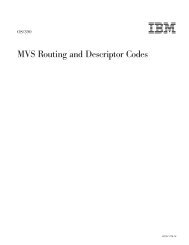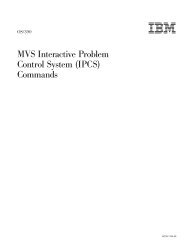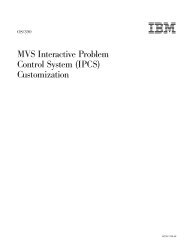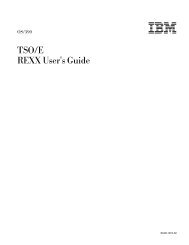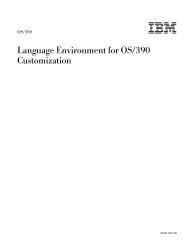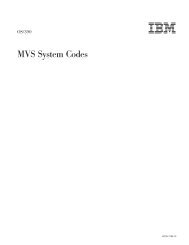OS/390 MVS IPCS User's Guid
OS/390 MVS IPCS User's Guid
OS/390 MVS IPCS User's Guid
Create successful ePaper yourself
Turn your PDF publications into a flip-book with our unique Google optimized e-Paper software.
v<br />
v<br />
Start analyzing one source using <strong>IPCS</strong> dialog panels. Then, enter the <strong>IPCS</strong><br />
Browse panel and specify a different source on it. The other <strong>IPCS</strong> dialog panels<br />
will continue showing the first source.<br />
Start analyzing one source using <strong>IPCS</strong> dialog panels. Then, enter a<br />
subcommand on the <strong>IPCS</strong> Commands panel and specify a different source in the<br />
subcommand. All further subcommands entered on the <strong>IPCS</strong> Commands panel<br />
will apply to the second source, but the other panels will apply to the first source.<br />
At any time, you can enter a subcommand specifying the first source to make<br />
subcommands entered on the <strong>IPCS</strong> Commands panel apply to the first source.<br />
PROFILE Default Values<br />
You can specify default values for the line size and the number of lines per page for<br />
printed output through the PROFILE subcommand. These defaults are recorded in<br />
your dump directory and remain in effect until you change them with another<br />
PROFILE subcommand.<br />
See the PROFILE subcommand in <strong>OS</strong>/<strong>390</strong> <strong>MVS</strong> <strong>IPCS</strong> Commands for more<br />
information.<br />
Address Processing Parameters<br />
The ASID and CPU parameters are address processing parameters that are part of<br />
the data description parameter. The data description parameter is used to describe<br />
storage in a dump. The ASID and CPU parameters are null until you specify a<br />
dump data set. When you specify a dump and access it with a dump analysis<br />
subcommand, that subcommand sets the ASID and CPU parameters to describe an<br />
address space contained in that dump.<br />
If possible, <strong>IPCS</strong> sets the ASID parameter to the address space identifier<br />
associated with the problem that caused the dump. However, it might not always be<br />
possible to do so, as in the following cases:<br />
v<br />
When a dump is initiated through an operator command, a stand-alone dump<br />
program, or a similar external mechanism, <strong>IPCS</strong> might not be able to identify the<br />
address space associated with the failure.<br />
v When there is truncation during recording or I/O errors during transcription, data<br />
needed to establish an appropriate default address space might not be present in<br />
a dump data set.<br />
In such circumstances, <strong>IPCS</strong> attempts to select a usable address space from which<br />
analysis can proceed, although the address space selected might not be one in<br />
which a failure occurred.<br />
If the dump is a stand-alone dump and if a store status operation was performed,<br />
the CPU parameter is set to the IPLed central processor number. Otherwise, the<br />
CPU parameter is set to another processor in the configuration or NOCPU is used.<br />
SETDEF rejects any attempt to set these parameters before you specify a dump.<br />
See <strong>OS</strong>/<strong>390</strong> <strong>MVS</strong> <strong>IPCS</strong> Commands for more information about the data description<br />
parameter and address processing parameters.<br />
Specifying the Source<br />
To analyze data in a source, specify the data set name as the source on the <strong>IPCS</strong><br />
Default Values panel, in a SETDEF subcommand, or in a parameter on a<br />
subcommand. If the source is active storage, specify the MAIN parameter.<br />
Chapter 2. Starting <strong>IPCS</strong> 17



